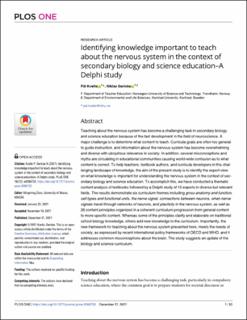| dc.description.abstract | Teaching about the nervous system has become a challenging task in secondary biology and science education because of the fast development in the field of neuroscience. A major challenge is to determine what content to teach. Curricula goals are often too general to guide instruction, and information about the nervous system has become overwhelming and diverse with ubiquitous relevance in society. In addition, several misconceptions and myths are circulating in educational communities causing world-wide confusion as to what content is correct. To help teachers, textbook authors, and curricula developers in this challenging landscape of knowledge, the aim of the present study is to identify the expert view on what knowledge is important for understanding the nervous system in the context of secondary biology and science education. To accomplish this, we have conducted a thematic content analysis of textbooks followed by a Delphi study of 15 experts in diverse but relevant fields. The results demonstrate six curriculum themes including gross anatomy and function, cell types and functional units, the nerve signal, connections between neurons, when nerve signals travel through networks of neurons, and plasticity in the nervous system, as well as 26 content principles organized in a coherent curriculum progression from general content to more specific content. Whereas some of the principles clarify and elaborate on traditional school biology knowledge, others add new knowledge to the curriculum. Importantly, the new framework for teaching about the nervous system presented here, meets the needs of society, as expressed by recent international policy frameworks of OECD and WHO, and it addresses common misconceptions about the brain. The study suggests an update of the biology and science curriculum. | en_US |

